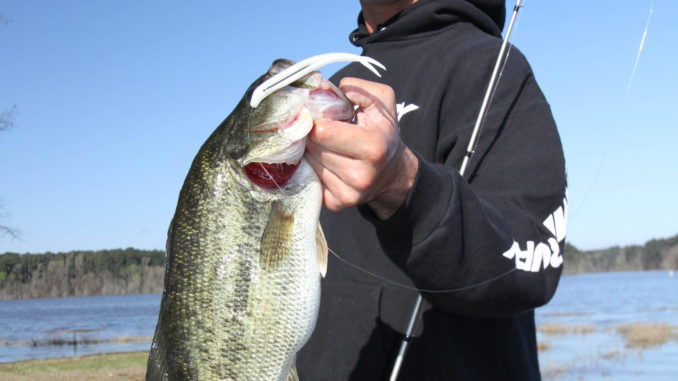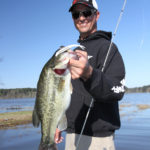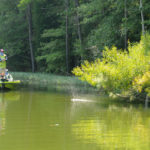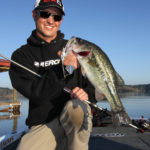
Topwater, soft-plastics and jigs are just a few of the baits that Lake Murray’s bass will hit when it’s hot.
It’s known as “The Jewel of South Carolina” and Lake Murray indeed shines with many facets. Located west of Columbia, the lake created in the late 1920s offers tremendous diversity, and as bass pros demonstrated during last year’s Forrest Wood Cup in July, Murray indulges a variety of fishing styles.
Tournament winner Anthony Gagliardi of nearby Prosperity caught fish using a number of different tactics. Targeting shallow, grass points where largemouth bass were chasing blueback herring, he caught fish on a 5-inch Basstrix swimbait threaded on a 3/8-ounce Buckeye swimbait head. When he ran up the Saluda River, he caught them on a Zoom Ole Monster worm Texas-rigged on a 4/0 hook with a ¼-ounce weight. For surface-feeding fish on the lower end of the lake, he caught them on Zoom Flukes and Yamamoto D-Shads on 4/0 weighted hooks.
Other pros found reliable patterns of their own. Here’s a rundown of other popular summer tactics for Lake Murray:
Surface attack: Casey Ashley of Donald’s, who won the Bassmaster Classic this past February on Lake Hartwell, fishined fourth on Murray, largely on the strength of his go-to summer tactic: working an Xcalibur Zell Pop in shady pockets with grass, seawalls and rock in the mid-lake area.
Keying on a bream pattern, Ashley alternated between Arkansas Shiner and Z-Shad colors. The latter saw the most action when he was casting to the bank, but whenever breaking fish rose in open water, he threw the shiner color.
“Those fish are up shallow eating bream, but the good thing about a Zell Pop is that it imitates bream and baitfish,” Ashley said. “The Z-Shad is more of a gold color that imitates a bream more and that Arkansas Shiner is silver so it’s more like a baitfish.”
Casting shallow, Ashley likes to work his bait out to about 15 to 20 feet off the bank, because he bass often sit out deeper and look toward the bank. A peppy retrieve of uninterrupted pop-pop-pop-pop-pop-pop attracts attention without allowing the fish time to examine the bait.
Brent Ehler, a California pro who finished third, also demonstrated the wisdom of a summertime topwater strategy by targeting banks with rocks, grass and wood in 10 to 15 feet of water with a Lucky Craft Gunfish, a slender, walking-style bait with a flat belly and a concave face that allows a chugging option.
Maintaining a rapid pace, Ehrler said he steered clear of banks with docks so he could make long, uninterrupted passes and keep his bait in the target zone. He found his efforts most productive when he made lengthy casts and retrieves parallel to the bank.
The buzz: One of Lake Murray’s most-exciting, shallow-water patterns is a buzzbait bite like the one runnerup Scott Canterbury of Alabama discovered. He had been alternating between a white Punisher buzzbait and a Zoom Horny Toad, but when he added the big plastic bait as a trailer, things really got fun.
“I could cover more water, and I felt more confident with the buzzbait because it had the exposed hook and I was less likely to miss any on that that,” Canterbury said.
The heavier rig allowed for longer casts, and the bulky trailer created a large profile the fish really attacked. No maybes — the ones that bit meant business.
When his buzzbait bite tapered off, or if he noticed fish that followed the bait but wouldn’t bite, he switched to a green pumpkin craw on a 3/8-ounce Dirty Jigs Tackle swim jig. Noticing the red tips of the claws on a couple of regurgitated crawfish he found in his livewell cued Canterbury to dye the tips of his soft-plastic trailer.
The swim jig follow-up played a key role in helping Canterbury dial in the right type of bottom. After catching a keeper on that subsurface presentation, he saw that his bite came over shallow grass flanked by gravel.
Canterbury said had seen warm-season scum over the grass in some of the pockets, while other spots had secondary vegetation growing amid the healthy grass. These gnarly spots held no fish, while the grass sprouting from clean bottom was the ticket.
“I think the crawfish were in the gravel bottom that the grass was growing in,” Canterbury surmised.
Fluke finds ’em: Ehrler’s morning routine exemplified a challenging, potentially productive summer pattern on Murray. He began each tournament day looking for bass crashing bait schools over flat points that dropped from 3 to 18 feet. Sunlight eventually capped this daily deal, but for the first couple of hours, Fluke-style baits delivered nearly nonstop action.
Ehrler rigged white D-Shads on 4/0 Gamakatsu EWG hooks and fished them on 15-pound fluorocarbon. A small swivel linked his main line to 2 feet of 14-pound leader.
Single D-Shads produced bites, but after two days of working the fish, Ehrler mixed it up on the final two days by throwing a double rig. He used the same main line and leader setup as his single rig, but before attaching the leader swivel, Ehrler ran his main line through the top eye of a second leader swivel. On the cast and retrieve, this secondary leader slides down to the main swivel, but the range of movement proved strategically beneficial.
“If you use a 3-way swivel and you get two fish on that decide to go in opposite directions, they’ll break your line,” Ehrler said. “With this rig, if you get two fish that go in opposite directions, one will just run up your line.”
Ehrler stressed casting precision. Blind casting produced few strikes, while casting directly to a boil proved most productive.
River run: The Big Saluda River’s abundance of wood, rocks and shoreline vegetation offers an attractive alternative to the main-lake habitat. When heavy summer rains swelled the river, Alabama pro Steve Kennedy took advantage of the rising water level, which granted fish access to the thickest of shoreline cover. Enhancing the deal was a mayfly hatch that had the fish in a snappin’ mood.
“Willows were the best on the last day because the fish had been up in the pockets flooded by recent rains, and when the water fell out, they pulled out to the edge of the willows,” Kennedy explained. “That mayfly hatch had those fish sitting up close to the surface.”
Targeting oxbows with willows on woody points, Kennedy spent the first two days catching fish on a black Spro Bronzeye frog, a 5/8-ounce green pumpkin jig with a green pumpkin Zoom Super Chunk, a chrome/blue Rattling Rogue and a watermelon Kinami Flash Texas-rigged with a 1/8-ounce bullet weight and a 4/0 hook. He also fished a Zoom Horny Toad on a 2/0 EWG hook, skipping the bait back into the shad, burning up to the edge and then killing it.
Deep drag: When summer’s heat makes the mid-day period tough, Ashley knew that Lake Murray bass might need a little convincing from a large-profile bait. One of his favorites is a Mop Jig with square skirt strands that spread out nicely.
“When the fish are out deep, they’re keying on big baits,” Ashley said. “They don’t want to move much, and when they eat, they want to eat something big, so you’re going to catch bigger fish on a Mop Jig.”
Ashley offers a nifty tip for rigging his trailer. Before adding a Zoom Super Chunk, he took an inch-long piece of discarded Trick worm and threaded it onto the shank of the jig’s hook. Serving as an impromptu spacer, the piece of worm keeps the trailer from sliding up the hook and marring the presentation.
“If you make a long cast, or even if you’re skipping docks, this keeps you from making a wasted cast,” Ashley said. “If you’ve made a cast and gotten your bait back with the chunk balled up on the jig; that was a wasted cast.”
Also effective for the clean-up duties are big worms of 10 inches or better. Ashley, for example, saved some time each afternoon for probing brush piles in deep water with a Zoom Ole Monster worm in red bug on a 5/0 hook with a ¼-ounce weight.
Complementing the Texas rig, Lake Murray anglers will do well with a big worm fitted on a skirtless football jig. An effective option for “painting” the bottom with a thorough, methodical presentation, a football head and big worm combo rumbles over rocky bottom with a serious profile that bass can’t ignore.
Another good option for brush piles is a drop-shot rig and shakey head. Depending on where the fish are sitting, one or the other may be more productive. Drop-shots are especially productive around brush because adjusting leader length influences where the worm hangs. Pineapple-style weights, which grip the line with a tension wire are a good choice here, as sliding the line in or out instantly adjusts depth.
And don’t forget the old ball-and-chain. Indeed, when the mid-day bite gets tough, a Carolina rig can keep the fun flowing through the afternoon. Target offshore structure or main-lake points with a creature bait, lizard or Fluke and adjust your leader as needed to appeal to the fish’s interest level.
A one-trick pony, Lake Murray is definitely not. Options are many, even during the heat of summer. Savvy anglers will diversify their offerings and adjust with time of day and prevailing conditions to get the most out of the Lake Murray bounty.
DESTINATION INFORMATION
HOW TO GET THERE — Lake Murray is on the Saluda River just west of Columbia. It has shoreline in Lexington, Newberry, Saluda and Richland counties. I-26 and I-20 provide good access to the lake, which is covered with public boat ramps. Two of the most popular are at Dreher Island State Park near Prosperity and the SCEG ramp at the dam.
WHEN TO GO — Bass fishing can be great on Murray in July, if only for the variety of tactics that will work, from fishing deep with Texas rigs or drop-shot rigs to topwaters like swimbaits buzzbaits and popping plug.
BEST TECHNIQUES — In the heat of the summer, all kinds of baits and techniques can work for a period of time, including topwater fishing around blueback herring schools, pitching and skipping soft plastics around wooden cover in the upper end of the lake, or targeting breaking fish at the surface with a variety of lures. Deep fish will respond to jigs and various worm rigs.
FISHING INFO/GUIDES — Brad Taylor, Taylor Outdoors, 803-331-1354, www.tayloroutdoors.com; Kyle Giella, KG’s Guide Service, 912-687-0913, www.kgfishing.com/guide-services; Chris Heinning, Capt. Chris Guide Service, 803-905-1991, www.captchrisfishing.com; Lake World, Lexington, 803-957-6548. See also Guides and Charters in Classifieds.
ACCOMMODATIONS — Lake Murray Country, 866-SC-JEWEL, www.lakemurraycountry.com.
MAPS — Kingfisher Maps, www.kfmaps.com.





Be the first to comment